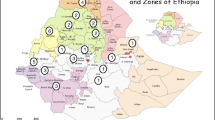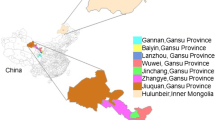Abstract
‘Candidatus Liberibacter solanacearum’ is associated with the Zebra Chip (ZC) disorder of potatoes. A panel of eight simple sequence repeat (SSR) markers was developed and used to genetically characterize ‘Ca. L. solanacearum’ strains obtained from ZC-affected potato plants in the United States and Mexico. The multilocus SSR markers in this study effectively differentiated genotypes and estimated genetic diversity of ‘Ca. L. solanacearum’ strains. Genotype assignment analyses identified two major lineages of ‘Ca. L. solanacearum’ in the North American populations while only one lineage type was identified in Mexican population. No clear genetic structure was found among haplotypes based on geographical proximity or host. The high resolution power of the SSR marker system developed in this study provides a useful tool for genotyping closely related strains and tracking sources of the pathogen. Genotype information combined with epidemiological data will advance knowledge of ZC disease and will facilitate development of effective disease management.


Similar content being viewed by others
References
Almeida, R. P. P., Nascimento, F. E., Chau, J., Prado, S. S., Tsai, C. W., Lopes, S. A., et al. (2008). Genetic structure and biology of Xylella fastidiosa strains causing disease in citrus and coffee in Brazil. Applied and Environmental Microbiology, 74, 3690–3701.
Amonsin, A., Li, L. L., Zhang, O., Bannantine, J. P., Motiwala, A. S., Sreevatsan, S., et al. (2004). Multilocus short sequence repeat sequencing approach for differentiating among Mycobacterium avium subsp. paratuberculosis strains. Journal of Clinical Microbiology, 42, 1694–1702.
Bové, J. M. (2006). Huanglongbing: a destructive, newly-emerging, century-old disease of citrus. Journal of Plant Pathology, 88, 7–37.
Chelossi, E., Milanese, M., Milano, A., Pronzato, R., & Riccardi, G. (2004). Characterisation and antimicrobial activity of epibiotic bacteria from Petrosia ficiformis (Porifera, Demospongiae). Journal of Experimental Marine Biology and Ecology, 309, 21–33.
Coletta-Filho, H. D., Takita, M. A., De Souza, A. A., Aguilar-Vildoso, C. I., & Machado, M. A. (2001). Differentiation of strains of Xylella fastidiosa by a variable number of tandem repeat analysis. Applied and Environmental Microbiology, 67, 4091–4095.
Coletta-Filho, H. D., Bittleston, L. S., & Almeida, R. P. P. (2011). Spatial genetic structure of a vector-borne generalist pathogen. Applied and Environmental Microbiology, 77, 2596–2601.
Evanno, G., Regnaut, S., & Goudet, J. (2005). Detecting the number of clusters of individuals using the software STRUCTURE: a simulation study. Molecular Ecology, 14, 2611–2620.
Gudmestad, N. C., & Secor, G. A. (2007). Zebra chip: a new disease of potato. Nebraska Potato Eyes, 19, 1–4.
Hansen, A. K., Trumble, J. T., Stouthamer, R., & Paine, T. D. (2008). A new huanglongbing species, “Candidatus liberibacter psyllaurous” found to infect tomato and potato, is vectored by the psyllid Bactericera cockerelli (sulc). Applied and Environmental Microbiology, 74, 5862–5865.
Jakobsson, M., & Rosenberg, N. A. (2007). CLUMPP: a cluster matching and permutation program for dealing with label switching and multimodality in analysis of population structure. Bioinformatics, 23, 1801–1806.
Jolley, K. A., Feil, E. J., Chan, M.-S., & Maiden, M. C. J. (2001). Sequence type analysis and recombinational tests (START). Bioinformatics, 17, 1230–1231.
Katoh, H., Subandiyah, S., Tomimura, K., Okuda, M., Su, H. J., & Iwanami, T. (2011). Differentiation of “Candidatus liberibacter asiaticus” isolates by variable-number tandem-repeat analysis. Applied and Environmental Microbiology, 77, 1910–1917.
Liefting, L. W., Perez-Egusquiza, Z. C., Clover, G. R. G., & Anderson, J. A. D. (2008). A new ‘Candidatus liberibacter’ species in Solanum tuberosum in New Zealand. Plant Disease, 92, 1474.
Liefting, L. W., Sutherland, P. W., Ward, L. I., Paice, K. L., Weir, B. S., & Clover, G. R. G. (2009). A new ‘Candidatus liberibacter’ species associated with diseases of solanaceous crops. Plant Disease, 93, 208–214.
Lin, H., Civerolo, E. L., Hu, R., Barros, S., Francis, M., & Walker, M. A. (2005). Multilocus simple sequence repeat markers for differentiating strains and evaluating genetic diversity of Xylella fastidiosa. Applied and Environmental Microbiology, 71, 4888–4892.
Lin, H., Doddapaneni, H., Munyaneza, J. E., Civerolo, E. L., Sengoda, V. G., Buchman, J. L., et al. (2009). Molecular characterization and phylogenetic analysis of 16s rRNA from a new “Candidatus liberibacter” strain associated with zebra chip disease of potato (Solanum tuberosum L.) and the potato psyllid (Bactericera cockerelli Sulc). Journal of Plant Pathology, 91, 215–219.
Lin, H., Lou, B. H., Glynn, J. M., Doddapaneni, H., Civerolo, E. L., Chen, C. W., et al. (2011). The complete genome sequence of ‘Candidatus liberibacter solanacearum’, the bacterium associated with potato zebra chip disease. PloS One, 6, e19135.
Munyaneza, J. E., Crosslin, J. M., & Upton, J. E. (2007). Association of Bactericera cockerelli (Homoptera: Psyllidae) with “zebra chip,” a new potato disease in southwestern United States and Mexico. Journal of Economic Entomology, 100, 656–63.
Munyaneza, J. E., Sengoda, V. G., Crosslin, J. M., De La Rosa-Lozano, G., & Sanchez, A. (2009). First report of ‘Candidatus liberibacter psyllaurous’ in potato tubers with zebra chip disease in Mexico. Plant Disease, 93, 552.
Munyaneza, J., Fisher, T., Sengoda, V., Garczynski, S., Nissinen, A., & Lemmetty, A. (2010). First report of “Candidatus liberibacter solanacearum” associated with psyllid- affected carrots in Europe. Plant Disease, 94, 639.
Mushegian, A. A., Peterson, C. N., Baker, C. C., & Pringle, A. (2011). Bacterial diversity across individual lichens: thallus centers house richer, more uniform communities than recently formed edges. Applied and Environmental Microbiology. doi:10.1128/AEM.02850-10.
Nelson, W. R., Fisher, T. W., & Munyaneza, J. E. (2011). Haplotypes of “Candidatus liberibacter solanacearum” suggest long-standing separation. European Journal of Plant Pathology, 130, 5–12.
Peakall, R., & Smouse, P. (2006). GENALEX 6: genetic analysis in Excel. Population genetic software for teaching and research. Molecular Ecology Notes, 6, 288–295.
Prager, E. M., & Wilson, A. C. (1978). Construction of phylogenetic trees for proteins and nucleic acids: empirical evaluation of alternative matrix methods. Journal of Molecular Evolution, 11, 129–142.
Pritchard, J., Stephens, M., & Donnelly, P. (2000). Inference of population structure using multilocus genotype data. Genetics, 155, 945–959.
Raddadi, N., Gonella, E., Camerota, C., Pizzinat, A., Tedeschi, R., Crotti, E., et al. (2011). ‘Candidatus liberibacter europaeus’ sp. nov. that is associated with and transmitted by the psyllid Cacopsylla pyri apparently behaves as an endophyte rather than a pathogen. Environmental Microbiology, 13, 414–426.
Raymond, M., & Rousset, F. (1995). GENEPOP (version 1.2): population genetics software for exact tests and ecumenicism. Journal of Heredity, 86, 248–249.
Rosenberg, N. A. (2004). DISTRUCT: a program for the graphical display of population structure. Molecular Ecology Notes, 4, 137–138.
Secor, G. A., Rivera, V. V., Abad, J. A., Lee, I. M., Clover, G. R. G., Liefting, L. W., et al. (2009). Association of ‘Candidatus liberibacter solanacearum’ with zebra chip disease of potato established by graft and psyllid transmission, electron microscopy, and PCR. Plant Disease, 96, 574–583.
Sola, C., Filliol, I., Legrand, E., Lesjean, S., Locht, C., Supply, P., et al. (2003). Genotyping of the Mycobacterium tuberculosis complex using MIRUs: association with VNTR and spoligotyping for molecular epidemiology and evolutionary genetics. Infection, Genetics and Evolution, 3, 125–33.
Wen, A., Mallik, I., Alvarado, V. Y., Pasche, J. S., Wang, X., Li, W., et al. (2009). Detection, distribution, and genetic variability of ‘Candidatus liberibacter’ species associated with zebra complex disease of potato in North America. Plant Disease, 93, 1102–1115.
Wittwer, M., Keller, J., Wassenaar, T. M., Stephan, R., Howald, D., Regula, G., et al. (2005). Genetic diversity and antibiotic resistance patterns in a campylobacter population isolated from poultry farms in Switzerland. Applied and Environmental Microbiology, 71, 2840–2847.
Yuan, X., Morano, L., Bromley, R., Spring-Pearson, S., Stouthamer, R., & Nunney, L. (2010). Multilocus sequence typing of Xylella fastidiosa causing Pierce’s disease and oleander leaf scorch in the United States. Phytopathology, 100, 601–611.
Acknowledgements
This work was supported by 2009 USDA National Institute of Food and Agriculture (NIFA) Specialty Crops Research Initiative (SCRI). Trade names or commercial products in this publication are mentioned solely for the purpose of providing specific information and does not imply recommendation or endorsement by the United States Department of Agriculture.
Author information
Authors and Affiliations
Corresponding author
Rights and permissions
About this article
Cite this article
Lin, H., Islam, M.S., Bai, Y. et al. Genetic diversity of ‘Cadidatus Liberibacter solanacearum’ strains in the United States and Mexico revealed by simple sequence repeat markers. Eur J Plant Pathol 132, 297–308 (2012). https://doi.org/10.1007/s10658-011-9874-3
Accepted:
Published:
Issue Date:
DOI: https://doi.org/10.1007/s10658-011-9874-3




